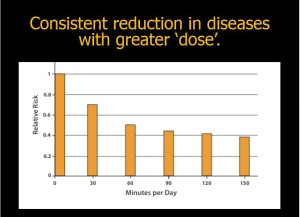 To all 23,000+ participants in Body Matters, the Massive Open Online Course (MOOC), congratulations on a wise choice and thanks for asking a BJSM opinion. What a great set of lectures to open the course! Kudos to Professor Ian Shrier and McGill University.
To all 23,000+ participants in Body Matters, the Massive Open Online Course (MOOC), congratulations on a wise choice and thanks for asking a BJSM opinion. What a great set of lectures to open the course! Kudos to Professor Ian Shrier and McGill University.
For those not privy to the MOOC, the class posed this question. ‘Is there anything to the idea that exercising way over the minimum requirement has harmful effects? Assuming no injuries etc. are people who run ultramarathon distances doing more harm than someone who puts in 150 minutes per week?’
No-one has all the answers so I plan to make 5 comments to stimulate more discussion. And remember, it’s a safe place to disagree.
1. 150 minutes per week is a minimum – it represents 22 minutes a day! These 22 minutes are the most valuable in your day to promote health. Interestingly, a recent BMJ Analysis paper (not open access) and podcast (open access) suggested that this was too much – a ‘stretch goal’ as it were. Really? I was shocked! Isn’t 22 minutes equal to one minute per hour? OK – let’s say you have narcolepsy (no offence) – then 22 minutes is 2 minutes every hour of the 11 hours you are awake. Too much? Wow!! Listen here and make up your own mind. Of course one could argue that public health advice should be based on the data. In that case one wouldn’t negotiate the minutes depending on what might be palatable. You might want to discuss this in your MOOC.
2. Would it be more palatable to call the ‘150 minutes a week’ just 23.5 hours of sitting and lying a day? ‘Look, you can sit around, watch TV, lie on a floating device in a massive Caribbean hotel pool, get hours of massage and spa treatment, sleep, but try to limit that to 23.5 hours a day, OK?’ Seem unrealistic? Impossible? Many of you will be familiar with this idea – as popularized (‘viralized’?) by the indomitable Canadian doctor – Mike Evans (@DocMikeEvans). Is he a guest professor in this MOOC? Watch the 23.5 hours YouTube video here. I would DEMAND that your professor, Ian Shrier, gets Dr Mike on board! When the class has 23,000 votes you should be able to beat a professor into submission. Please don’t take that literally.
3. Doses beyond 150 minutes per week. Is 60 minutes the magic number?
Do you drive the worst car possible? The bare minimum to get from A to B. Do you have the worst possible accommodation and food? Just to survive? Unfortunately, that’s all many people can afford to do. But many others are in a position to upgrade beyond basic food, shelter and transport. They are prepared to pay for what they perceive as value.
The bare minimum of physical activity is 22 minutes a day – 150 minutes per week. That is an appropriate public health guideline and the correct focus for the committees that made these recommendations. The most bang for very little buck. However, the evidence is very clear that an additional 30 minutes a day of physical activity (let’s call it 60 minutes in total for convenience) brings substantial additional benefit. This will prevent cardiac disease, cancers and dementia. My favourite paper capturing this is by the quietly spoken Professor Ken Powell in partnership with – you guessed it – Steven Blair. I’ve reproduced the key graph here.
On the vertical axis, ‘Relative Risk’ of 1.0 represents risk of many chronic conditions in the setting of physical inactivity (first column, 0 minutes of physical activity daily). On the horizontal axis, you can see how various doses of physical activity reduce the risk of diseases. Move one bar to the right, and notice that at 30 minutes of physical activity daily (‘150 minutes a week’) there is a Relative Risk of 0.7 (compared with 1.0) which represents a 30% reduction in risk of disease. Moving further along to the right, 60 minutes of physical activity a day provides a Relative Risk of 0.5, a 50% reduction in major diseases.
Can you imagine the popularity of a drug if one were to provide such benefits? Would you want to take one pill (30% risk reduction – 22 minutes a day?) or would you sneak a 2nd pill when the supervisor was distracted on Facebook (this would give you a 50% reduction in risk of major diseases).
If you were not already aware of this, then you have learned something very practical in this course – you can reduce your risk of the major killers grouped as ‘non-communicable diseases’ by an additional 20% just by building an extra 30 minutes of physical activity into your day. Walking is fine – no lycra required. 10 minute bouts are fine – you learned that on Monday.
Two points to go – what about long distance running/ultramarathons – safe or harmful? I’ll share some thoughts about (4) running and the risk of osteoarthritis, and (5) many many marathons and the heart.
But not today. I’m choosing to boost my physical activity dose from 30 minutes to 60 minutes by riding home from work. I’ll answer the rest of the question tomorrow, all being well.
Karim Khan (@BJSM_BMJ)
One of the 3 lead editors at the BJSM – along with Babette Pluim (@DocPluim) and Jill Cook (@ProfJillCook).

